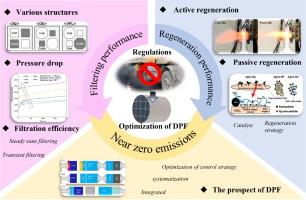Overview of technological development challenges of diesel particulate filters adapting to future emission regulations
IF 13.3
1区 工程技术
Q1 ENGINEERING, CHEMICAL
引用次数: 0
Abstract
In order to address air pollution and global climate change, countries around the world have established regulations to limit pollutant emissions. Therefore, aftertreatment technologies, such as diesel particulate filters (DPFs), must be employed to filter Particulate matter from the exhaust gases and meet the emission limits set by regulations. This paper reviews the composition of diesel particulate matter, the principles and structure of DPFs, and the recent changes in emission regulations. It also examines the technological evolution of DPF systems in response to stricter standards. Furthermore, it explores cutting-edge advancements in filtration technologies, including the application of new materials and strategies for improving filtration efficiency. In addition, the paper provides a comprehensive review of the latest research on regeneration technologies, particularly those aimed at improving regeneration efficiency and reducing energy consumption during the regeneration process. The paper highlights and compares the advantages and disadvantages of various DPF regeneration methods and the pollutant emissions during the regeneration process. Additionally, this review discusses the research hotspots for DPF under the new regulatory framework and explores the future directions of DPF development based on current research. This review provides valuable insights for promoting DPF technology to meet future emission regulations and contributes to achieving near-zero emissions for internal combustion engines.


柴油微粒滤清器适应未来排放法规的技术发展挑战概述
本文章由计算机程序翻译,如有差异,请以英文原文为准。
求助全文
约1分钟内获得全文
求助全文
来源期刊

Chemical Engineering Journal
工程技术-工程:化工
CiteScore
21.70
自引率
9.30%
发文量
6781
审稿时长
2.4 months
期刊介绍:
The Chemical Engineering Journal is an international research journal that invites contributions of original and novel fundamental research. It aims to provide an international platform for presenting original fundamental research, interpretative reviews, and discussions on new developments in chemical engineering. The journal welcomes papers that describe novel theory and its practical application, as well as those that demonstrate the transfer of techniques from other disciplines. It also welcomes reports on carefully conducted experimental work that is soundly interpreted. The main focus of the journal is on original and rigorous research results that have broad significance. The Catalysis section within the Chemical Engineering Journal focuses specifically on Experimental and Theoretical studies in the fields of heterogeneous catalysis, molecular catalysis, and biocatalysis. These studies have industrial impact on various sectors such as chemicals, energy, materials, foods, healthcare, and environmental protection.
 求助内容:
求助内容: 应助结果提醒方式:
应助结果提醒方式:


